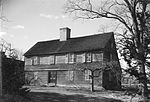Tuxis Island
Tuxis Island, sometimes uncommonly spelled Tunxis, is a small, uninhabited island about 1,029 feet (314 m) off the shore of Madison in New Haven County, Connecticut in the United States. Tuxis Island is about 3.42 acres (1.38 ha) in area, and covered mostly in trees. The island's elevation is 16 feet (4.9 m) above sea level. Tuxis Island was formed by glaciers, a fact that is evident by the many glacial potholes and small boulders on the south of the island. The island itself is made mostly of granite, like most of the other islands nearby, although there is some sand. Two other islands, Gull Rock and Round Rock, are relatively close to Tuxis, as is Madison Reef to the south, and several unnamed rocks and islets. These landforms are sometimes associated with the Thimble Islands. The name Tuxis comes from the Native words Tuxisshoag and Tuckshishoag.Tuxis Island is closed to people without permission from May to August to protect the many species of birds that nest there.Tuxis Road in Madison Connecticut was also named after the island.
Excerpt from the Wikipedia article Tuxis Island (License: CC BY-SA 3.0, Authors).Tuxis Island
Middle Beach Road,
Geographical coordinates (GPS) Address Nearby Places Show on map
Geographical coordinates (GPS)
| Latitude | Longitude |
|---|---|
| N 41.2663 ° | E -72.6019 ° |
Address
Round Rock
Middle Beach Road
06443
Connecticut, United States
Open on Google Maps




